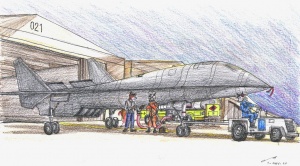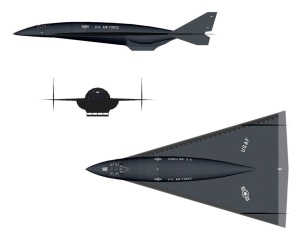Difference between revisions of "SR-91 Aurora"
Jump to navigation
Jump to search
Lafayette1 (talk | contribs) |
Lafayette1 (talk | contribs) |
||
| (19 intermediate revisions by the same user not shown) | |||
| Line 1: | Line 1: | ||
| + | {{Original research}} | ||
| + | |||
{|{{Infobox Aircraft Begin | {|{{Infobox Aircraft Begin | ||
|name = SR-91 "Aurora" | |name = SR-91 "Aurora" | ||
| − | |image = Image: | + | |image = Image:Aurora2.jpg |
|caption = | |caption = | ||
}}{{Infobox Aircraft Type | }}{{Infobox Aircraft Type | ||
| Line 16: | Line 18: | ||
|produced = 2007 to present | |produced = 2007 to present | ||
|number built = 7 | |number built = 7 | ||
| − | |unit cost = | + | |unit cost = $2.42 billion (approx.) |
}} | }} | ||
|} | |} | ||
| + | The '''Rubin Design SR-91''' is an advanced, high-altitude strategic reconnaissance aircraft developed by [[Rubin Design Aerospace|Rubin Design Defense Systems]] for use by the United States Air Force. It provides day and night, high-altitude (120,000 feet ASL and above), all-weather surveillance. The aircraft is also being developed for future use in satellite calibration, and satellite data validation. | ||
==History== | ==History== | ||
| Line 31: | Line 34: | ||
==Operational history== | ==Operational history== | ||
| + | ===Flight test program=== | ||
| + | |||
| + | <div class="infobox" style="width:30em;"> | ||
| + | '''SR-91 Aurora Performance''' | ||
| + | <br>Longest Flight: | ||
| + | <br>Fastest Speed: | ||
| + | <br>Highest Altitude: | ||
| + | <br>Highest Mach Number: Mach 9.05 | ||
| + | <br>Sustained Mach 9: | ||
| + | <br>Mach 9 total: | ||
| + | </div> | ||
==Variants== | ==Variants== | ||
| + | |||
| + | |||
| + | |||
| + | ==Popular Culture== | ||
==Specifications== | ==Specifications== | ||
| Line 59: | Line 77: | ||
|max takeoff weight main=157,000 lb | |max takeoff weight main=157,000 lb | ||
|max takeoff weight alt=71,215 kg | |max takeoff weight alt=71,215 kg | ||
| − | |engine (jet)= | + | |
| − | |type of jet=afterburning | + | |engine (jet)=Pratt & Whitney J58-1 |
| − | |number of jets= | + | |type of jet= afterburning turbojets |
| − | |thrust main=267 kN est. | + | |number of jets=4 |
| − | | | + | |thrust main= 32,500 lbf |
| + | |thrust alt=267 kN est. | ||
| + | |more general= '''High Speed Powerplant:''' 4× ramjets, scramjets or pulse detonation engines | ||
| + | |||
|max speed main=unknown at sea level | |max speed main=unknown at sea level | ||
|max speed alt=Mach 10 at altitude | |max speed alt=Mach 10 at altitude | ||
| Line 78: | Line 99: | ||
===Fuel types=== | ===Fuel types=== | ||
*JP-7 or JP-8 | *JP-7 or JP-8 | ||
| − | *Methane | + | *Methane, LH<sub>2</sub> or hydrogen fuel cells. |
*Possible use of liquid oxygen and hydrogen oxides. | *Possible use of liquid oxygen and hydrogen oxides. | ||
| − | *Possible use of MHD ( | + | *Possible use of MHD ([[Wikipedia:Magnetohydrodynamics|Magnetohydrodynamics]]) technology. |
===Other equipment=== | ===Other equipment=== | ||
| Line 86: | Line 107: | ||
*IR sensors | *IR sensors | ||
*Other advanced recon sensors | *Other advanced recon sensors | ||
| + | |||
| + | ==Notes== | ||
| + | {{reflist}} | ||
Latest revision as of 00:28, 18 July 2009
| This article may contain original research or unverified claims. Please improve the article by adding references. See the talk page for details. |
| SR-91 "Aurora" | |
|---|---|
| Role | Strategic Reconnaissance Aircraft |
| Manufacturer | Rubin Design Aerospace |
| First flight | 2007 |
| Status | Testing |
| Primary users | U.S. Air Force International Space Agency |
| Produced | 2007 to present |
| Number built | 7 |
| Unit cost | $2.42 billion (approx.) |
| Developed from | SR-71 Blackbird North American X-15 XB-70 Valkyrie |
The Rubin Design SR-91 is an advanced, high-altitude strategic reconnaissance aircraft developed by Rubin Design Defense Systems for use by the United States Air Force. It provides day and night, high-altitude (120,000 feet ASL and above), all-weather surveillance. The aircraft is also being developed for future use in satellite calibration, and satellite data validation.
Contents
History
Design and operational details
Air inlets
Fuselage
Stealth
Fuel
Life support
Sensors and payloads
Operational history
Flight test program
SR-91 Aurora Performance
Longest Flight:
Fastest Speed:
Highest Altitude:
Highest Mach Number: Mach 9.05
Sustained Mach 9:
Mach 9 total:
Variants
Popular Culture
Specifications
General characteristics
- Crew: 2 (1 pilot, 1 reconnaissance systems officer)
- Length: 35 m (115 ft)
- Wingspan: 20 m (65 ft)
- Height: 6 m (19 ft)
- Wing area: 300 m² (3,200 ft²)
- Empty weight: 29,480 kg (65,000 lb)
- Max takeoff weight: 71,215 kg (157,000 lb)
- Max takeoff weight: 157,000 lb (71,215 kg)
- Powerplant: 4× Pratt & Whitney J58-1 afterburning turbojets, 32,500 lbf (267 kN est.) each
- High Speed Powerplant: 4× ramjets, scramjets or pulse detonation engines
Performance
- Maximum speed: unknown at sea level (Mach 10 at altitude)
- Range: 9,320 mi (15,000 km)
- Service ceiling: 40,000 m (131,000 ft)
- Thrust/weight: 0.70 est.
Fuel types
- JP-7 or JP-8
- Methane, LH2 or hydrogen fuel cells.
- Possible use of liquid oxygen and hydrogen oxides.
- Possible use of MHD (Magnetohydrodynamics) technology.
Other equipment
- Cameras
- IR sensors
- Other advanced recon sensors

